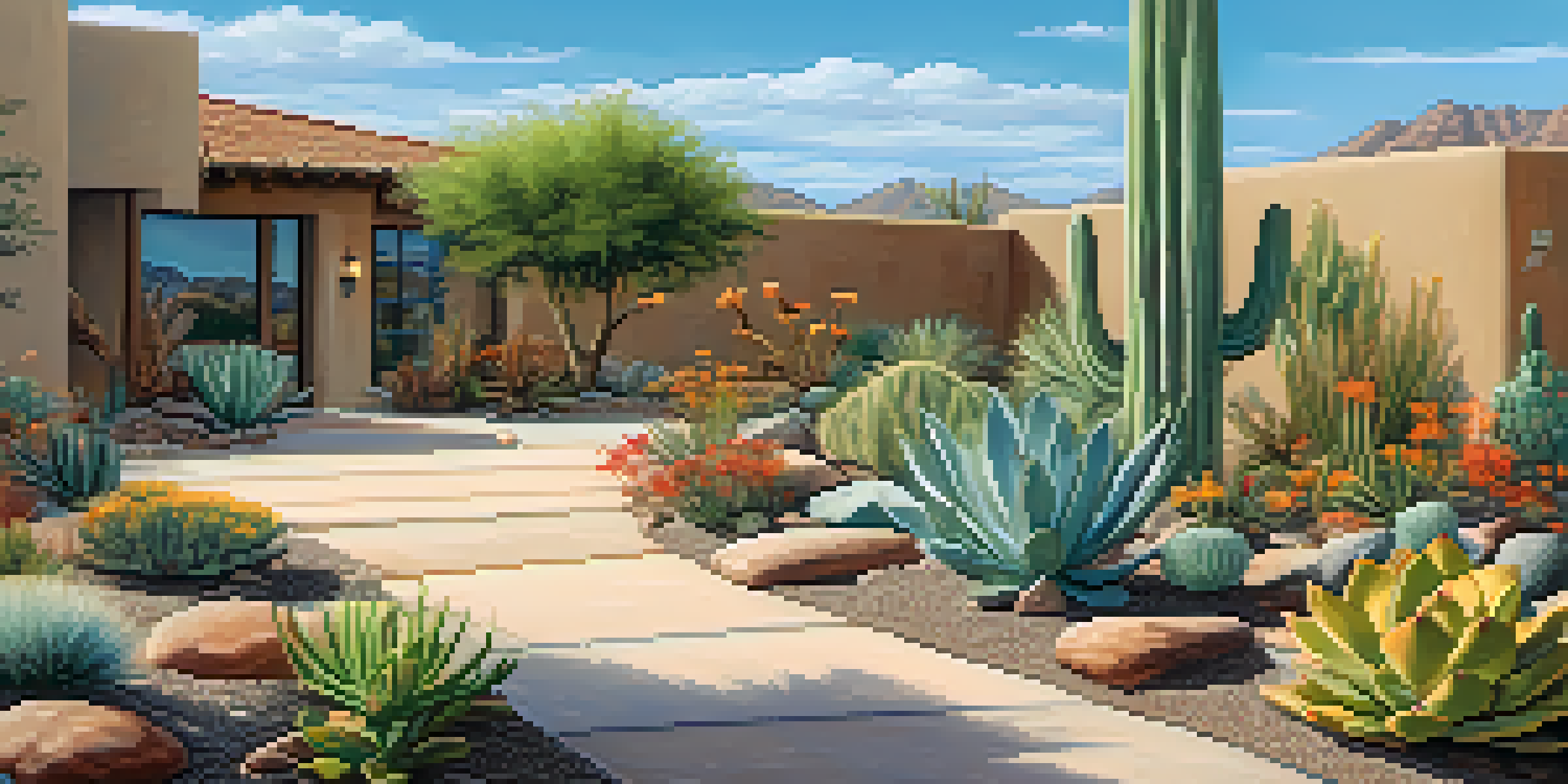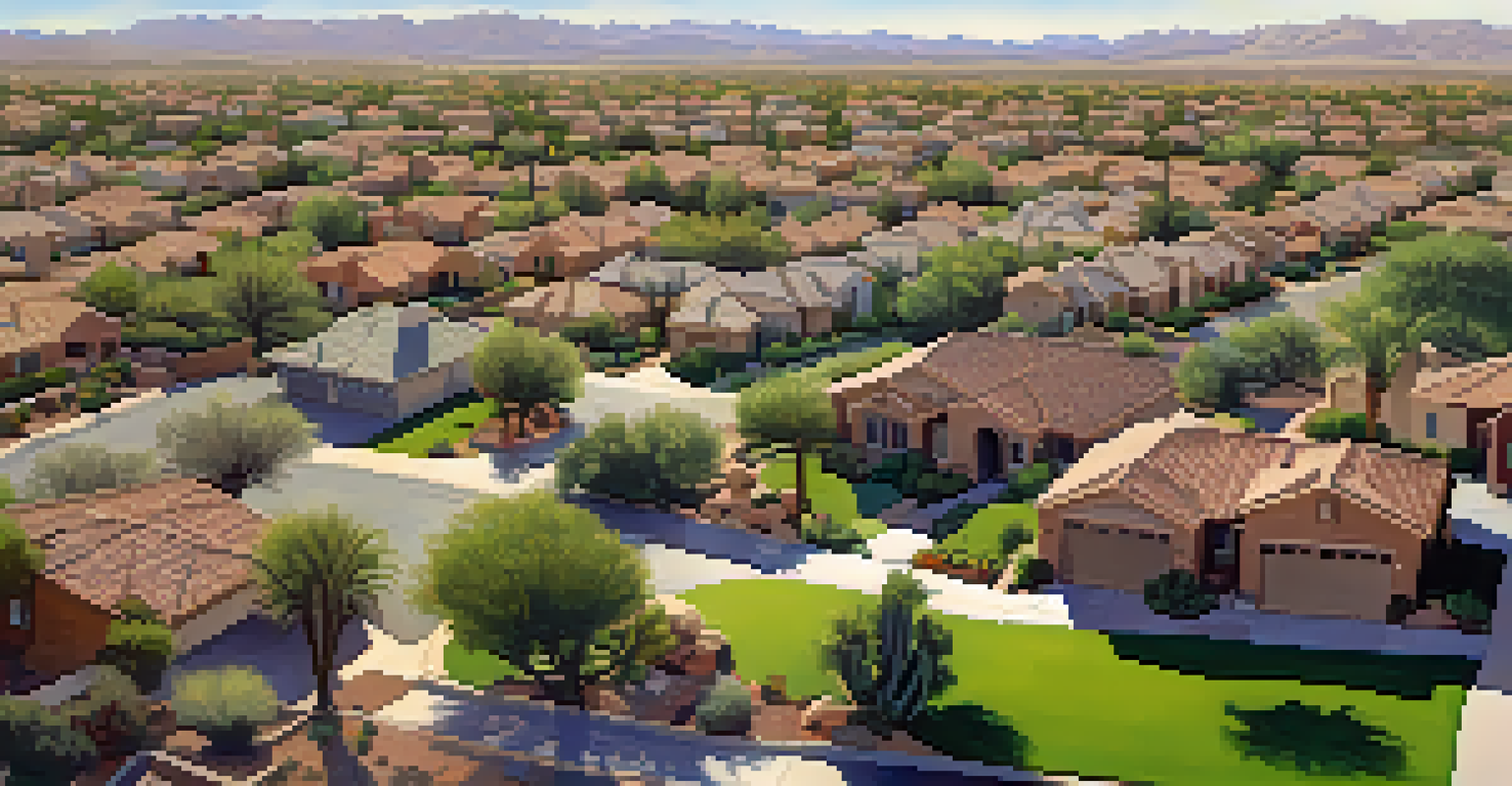Water Conservation Techniques for Arizona Residents

Understanding Arizona's Unique Water Challenges
Arizona's arid climate poses significant water conservation challenges. With limited rainfall and high evaporation rates, residents must be proactive in their water usage. The state's reliance on groundwater and surface water sources makes it crucial to implement effective techniques for sustainable living.
Water is the driving force of all nature.
Many residents may not realize that in some areas of Arizona, water is a scarce resource. This scarcity can lead to increased costs and regulations around water use. Understanding these challenges is the first step towards adopting better water conservation habits.
By being aware of the unique conditions that affect water availability in Arizona, residents can make informed choices. This awareness fuels a collective effort to protect this vital resource, ensuring its availability for future generations.
Collecting Rainwater: A Practical Approach
One of the most effective ways to conserve water in Arizona is by collecting rainwater. Installing rain barrels or cisterns can help capture precious precipitation during the monsoon season. This harvested water can then be used for irrigation or other non-potable uses, reducing reliance on municipal supplies.

Rainwater harvesting not only conserves water but also decreases stormwater runoff. By directing rainwater into storage systems, residents can minimize flooding and erosion on their properties. This dual benefit makes rainwater collection a smart, eco-friendly choice.
Embrace Rainwater Harvesting
Collecting rainwater through barrels or cisterns can significantly reduce reliance on municipal water supplies while benefiting the environment.
Moreover, many local governments in Arizona offer rebates and incentives for residents who install rainwater harvesting systems. These programs make it easier for homeowners to adopt this sustainable practice, ultimately contributing to a more resilient water supply.
Xeriscaping: Designing a Water-Wise Landscape
Xeriscaping is a landscaping method that reduces or eliminates the need for supplemental water from irrigation. By using drought-resistant plants and efficient landscaping techniques, Arizona residents can create beautiful outdoor spaces that require minimal water. This approach is particularly well-suited to the state's dry conditions.
We never know the worth of water till the well is dry.
Incorporating native plants into your landscape not only conserves water but also supports local wildlife. These plants are adapted to the climate and soil, making them easier to maintain. Plus, they often require less fertilizer and pesticide, which is better for the environment.
Transitioning to a xeriscaped yard can also increase your property’s value. Homebuyers are increasingly seeking water-efficient properties, making xeriscaping a smart investment for the future.
Efficient Irrigation Systems: The Key to Saving Water
Investing in efficient irrigation systems can significantly reduce water waste in your garden. Drip irrigation, for instance, delivers water directly to the plant roots, minimizing evaporation and runoff. This targeted approach ensures that plants receive the right amount of moisture without overwatering.
Additionally, setting up a smart irrigation controller can optimize your watering schedule based on weather conditions. These devices automatically adjust the watering frequency and duration, ensuring that your landscape remains healthy while conserving water.
Adopt Xeriscaping for Efficiency
Using drought-resistant plants and efficient landscaping techniques helps create beautiful, low-water-use gardens that thrive in Arizona's dry climate.
Taking the time to regularly check and maintain your irrigation system is equally important. Fixing leaks and adjusting sprinkler heads can make a big difference in water savings, allowing you to enjoy a lush garden without straining local water resources.
Water-Saving Fixtures: Small Changes, Big Impact
Upgrading to water-efficient fixtures in your home can lead to significant savings. Low-flow faucets, showerheads, and toilets use less water without sacrificing performance. These simple changes can dramatically reduce water consumption while keeping your household comfortable.
For example, a low-flow showerhead can save up to 2.5 gallons of water per minute. Over time, this can add up to substantial savings on your water bill, making it a win-win situation for both your wallet and the environment.
Many local utility companies offer rebates for installing water-saving devices. This makes it easier for Arizona residents to transition to more sustainable options, helping to create a culture of conservation within the community.
Educating the Community: Spreading Awareness
Education plays a vital role in water conservation efforts within Arizona. By sharing knowledge about water-saving techniques with friends, family, and neighbors, residents can foster a community-wide commitment to sustainability. Workshops, local events, and online resources can be powerful tools for spreading awareness.
Schools can also participate by integrating water conservation education into their curricula. Teaching students about the importance of water conservation can instill lifelong habits that benefit the environment and their communities.
Community Efforts Enhance Conservation
Collaborative initiatives and education within communities can strengthen water conservation efforts, ensuring sustainable practices for future generations.
Community programs that focus on water-saving initiatives can drive collective action. When residents work together, they can create a larger impact, ultimately helping to preserve Arizona's precious water resources for generations to come.
Monitoring Your Water Usage: Staying Informed
Keeping track of your water usage is essential for identifying areas where you can improve. Many water providers in Arizona offer online tools or apps that allow residents to monitor their consumption in real-time. This information can help you make informed decisions about your water use and pinpoint specific changes you can make.
By regularly reviewing your water bill and usage data, you can set realistic conservation goals. For instance, if you notice a sudden spike in usage, it may indicate leaks or inefficiencies in your system that need addressing. Being proactive in monitoring can save you money and conserve water.

Sharing your water usage insights with your community can foster a supportive environment for conservation. When neighbors share their successes and challenges, it can motivate everyone to stay committed to water-saving practices.
The Importance of Community Action in Water Conservation
While individual efforts are essential, community action amplifies the impact of water conservation. Collaborating with local organizations can lead to larger projects, such as community gardens or neighborhood rainwater harvesting initiatives. These projects can serve as a model for sustainable living and inspire others to take action.
Engaging in local government efforts to promote water conservation can also make a difference. Residents can advocate for policies that prioritize sustainable water management and support initiatives that protect Arizona's water resources.
Ultimately, when communities come together to focus on water conservation, they create a stronger, more resilient environment. This collective effort not only benefits individuals but also enhances the quality of life for everyone in the region.